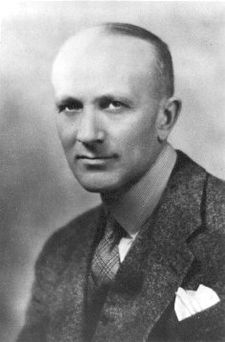<Back to Index>
- Neurosurgeon Wilder Penfield, 1891
- Sculptor Jean-Baptiste Pigalle, 1714
- King of Sweden Karl XIV Johan (Jean-Baptiste Bernadotte), 1763

Wilder Graves Penfield, OM, CC, CMG, FRS (January 26, 1891 – April 5, 1976) was an American born Canadian neurosurgeon. During his life he was called "the greatest living Canadian". He devoted much thinking to the functionings of the mind, and continued until his death to contemplate whether there was any scientific basis for the existence of the human soul. Penfield was a groundbreaking researcher and highly original surgeon. With his colleague, Herbert Jasper, he invented the Montreal procedure, in which he treated patients with severe epilepsy by destroying nerve cells in the brain where the seizures originated. This technique also allowed him to create maps of the sensory and motor cortices of the brain showing their connections to the various limbs and organs of the body. Along with Herbert Jasper, he published this work in 1951 (2nd ed., 1954) as the landmark Epilepsy and the Functional Anatomy of the Human Brain.
Penfield reported that stimulation of the temporal lobes could lead to vivid recall of memories. This seeded the common misconception that the brain continuously
"records" experiences in perfect detail, although these memories are
not available to conscious recall. In reality, however, the reported
episodes of recall occurred in less than five percent of his patients,
and these results have not been replicated by modern surgeons. His development of the neurosurgical technique that produced the less injurious meningo-cerebral scar became widely accepted in the field of neurosurgery, where the "Penfield dissector" is still in daily use. Penfield was born in Spokane, Washington, and studied at Princeton University before winning a Rhodes Scholarship to Merton College, Oxford, where he studied neuropathology under Sir Charles Scott Sherrington. He obtained his medical degree from Johns Hopkins University. He spent several years training at Oxford, where he met William Osler. He also studied in Spain, Germany, and New York. After taking surgical apprenticeship under Harvey Cushing, he obtained a position at the Neurological Institute of New York, where he carried out his first solo operations against epilepsy. While in New York, he met David Rockefeller,
who desired to endow an institute where Penfield could study the
surgical treatment of epilepsy. However, academic politics among the
New York neurologists prevented the establishment of this institute in
New York; subsequently, Penfield moved to Montreal in 1928. There, he taught at McGill University and the Royal Victoria Hospital, becoming the city's first neurosurgeon. In 1934 he founded and became the first Director of McGill University's world-famous Montreal Neurological Institute and the associated Montreal Neurological Hospital, which was established with funding from the Rockefeller Foundation. He retired in 1960 and turned his attention to writing, producing a novel as well as his autobiography, No Man Alone. In 1967 he was made a Companion of the Order of Canada. In 1994 he was inducted into the Canadian Medical Hall of Fame. Much of his archival material is housed at the Osler Library of McGill University. In
his later years, Penfield dedicated himself to the public interest,
particularly in support of university education. With his friends Governor-General Georges Vanier and Mrs. Pauline Vanier,
née Archer, he co-founded the Vanier Institute of the Family,
which Penfield helped found "to promote and guide education in the home
-- man's first classroom." He was also an early proponent of
bilingualism from childhood onward. Avenue du Docteur-Penfield , on the slope of Mount Royal in
Montreal, was named in Penfield's honour on October 5, 1978. Part of
this avenue borders McGill's campus and actually intersects with
Promenade Sir-William-Osler - to the amusement of many medical
historians who can say "meet me at Osler and Penfield".